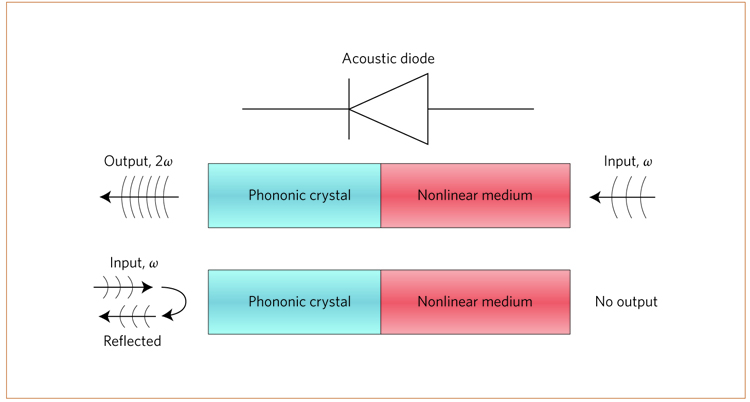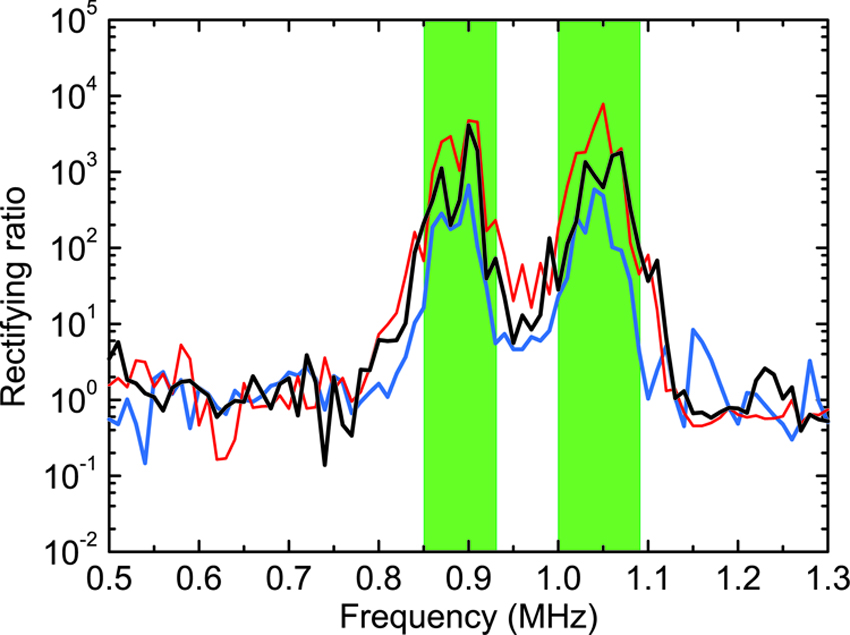
Bin Liang - liangbin@nju.edu.cn
Xia-sheng Guo - guoxs@nju.edu.cn
Juan Tu - juantu@nju.edu.cn
Dong Zhang - dzhang@nju.edu.cn
Jian-chun Cheng - jccheng@nju.edu.cn
Key Laboratory of Modern Acoustics, MOE, Institute of Acoustics
Department of Physics
Nanjing University, Nanjing 210093, P. R. China
Popular Version of Paper 2aEA4
Presented Tuesday morning, May 15, 2012
163rd ASA Meeting, Hong Kong
As we all know, most of the roads allow the cars to travel in both directions. But it is necessary to control the traffic under certain circumstances, e.g., in some congested streets, by directing the vehicles to move in only one direction. Usually, waves can propagate just as easily in both directions along a given path, while scientists can also design some "one-way streets" to control them in a similar manner. The most famous example is the electric diode used to restrict current flow in one particular direction, which is termed as "rectification". Similar devices also exist for light and heat transmission.
Considering the worldwide revolutions led by the emergence of electric diode, it should be intriguing to make such one-way devices for acoustic waves, which have much longer research history than electricity and apply almost everywhere in our daily life. However, there exists no analogous method to "rectifying" sounds because of the way sound moves in a medium. Actually, in acoustics there is a classical "reciprocal theorem" which states that the transmission in any linear acoustic system is symmetric. In other words, for a speaker and a listener, the listening effect will not be affected if they swap their locations, as traditionally perceived. Hence the rectification of acoustic waves have always remained a challenge, until an "acoustic diode" was recently proposed theoretically and realized experimentally.
The basic model of an acoustic diode consists of two segments. The first is a special acoustic medium with strong acoustic "nonlinearity". This nonlinear medium is used for breaking through the bounds of reciprocal theorem which stands for any linear system. In such a medium, the sound enters at a particular frequency (pulsations per second) and will be partially converted into a second wave of twice (or another integer multiple of) the original frequency. This is in direct analogy of the creation of overtones in musical instruments. In the experiment, a layer of ultrasound contrast agent microbubble suspension, which has particularly strong acoustic nonlinearity and is widely used in ultrasound radiography to enhance the imaging quality of ultrasonic diagnostics, was used to produce the nonlinear medium sample. The other essential part in acoustic diode is a "phononic crystal", a periodic structure made from alternating layers of two different kinds of media. In the experimental, they are chosen as water and glass for the convenience of fabrication. The phononic crystal acts as an effective acoustic filter, because its "bandgap" prevents acoustic waves with frequencies within this bandgap from being transmitted through the structure. The frequency range of the bandgap can be altered by adjusting the elastic constant, mass density and layer thickness of the media I and II. The schematic diagram of an acoustic diode is illustrated in Fig. 1.

Figure 1 Schematic diagram of the acoustic diode sample.
Similar to the case of electric diode, one can define the positive and the negative directions for an acoustic diode. In general, the positive direction refers to the propagating direction of acoustic wave incident from the side of the nonlinear medium, and the opposite direction is defined as the negative direction. And the phononic crystal in the acoustic diode is tuned to yield a bandgap at the frequency of the incident wave but allow the waves of doubled frequency to pass. The acoustic diode then works as follows (See Fig. 1). An acoustic wave coming in the positive direction has to hit and then go through the nonlinear material first, which creates the overtones. Although the wave with the original frequency lies within the bandgap of the phononic crystal and will be blocked, the generated wave with doubled frequency will pass freely through the structure. However, an acoustic wave arriving from the other side will be totally reflected because only the original frequency is present, and this lies within the bandgap of the superlattice. In this case, the system works as an acoustic insulator.
In the experiment, a significant rectifying effect was observed within two frequency ranges that agreed well with theoretical predictions. Figure 2 plots the measured rectifying ratio for the acoustic diode prototype fabricated in the experiment. The rectifying ratio is defined, for a quantitative evaluation of the rectifying performance of an acoustic diode, as the ratio between the acoustic transmissions along the positive and negative directions. The green regions denote the calculated frequency ranges where the acoustic rectification is expected to occur. The performance of the acoustic diode prototype was confirmed by the remarkably high value of the measured rectifying ratios. At an appropriate ultrasound contrast agent microbubble concentration, the highest magnitude of the rectifying ratio approximates 104 with the incident wave driven at a source frequency of 1.06 MHz (1MHz=106Hz). This means the energy of the acoustic wave propagating along the positive direction is almost ten thousand times larger than that along the negative direction. The one-way propagation of acoustic waves in an acoustic diode then turned out to be very efficient.

Figure 2 Comparison of the rectifying ratios for the acoustic diodes formed with three different nonlinear media samples. Results for nonlinear media samples produced using SonoVueR microbubble suspensions with volume concentrations of ~0.025% (blue line), 0.05% (red line) or 0.1% (black line), respectively.
With the first experimental realization of an acoustic diode, acoustic waves should no longer be considered to always travel easily in both directions in a given path as perceived traditionally. Although the acoustic diode is more like a conceptual prototype in the current stage, whose transmission efficacy and stability are considerably low, its development will inspire the interests and investigations in the more practical and efficient acoustic diodes in the future. This should have substantial significance for various practical situations where the acoustic waves need to be specially controlled, for example, the significant medical application of ultrasound. Most of the information and figures in this article are from Nature Mater. 9, 989-992 (2010) and Nature Mater. 9, 962-963 (2010).